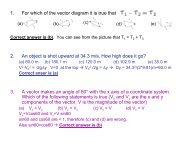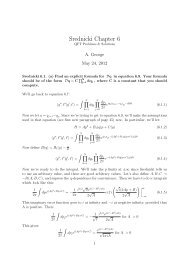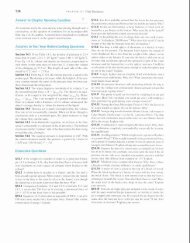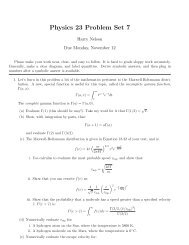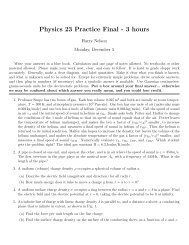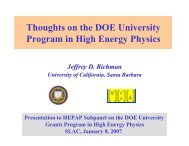Chapter 4 - UCSB HEP
Chapter 4 - UCSB HEP
Chapter 4 - UCSB HEP
Create successful ePaper yourself
Turn your PDF publications into a flip-book with our unique Google optimized e-Paper software.
WORK AND ENERGY<br />
Alternatively, we can use indefinite upper limits in Eq. (4.3):<br />
+mv2 - +mva2 = 1%: F(I) dr,<br />
where v is the speed of the particle when it is at position z. Equation<br />
(4.4) gives us v as a function of x. Since v = dxldt, we could<br />
solve Eq. (4.4) for dsJdt and integrate again to find x(t). Rather<br />
than write out the general formula, it is easier to see the method<br />
by studying a few examples.<br />
Example 4.1<br />
Mass Thrown Upward in a Uniform Gravitational Field<br />
A mass m is thrown vertically upward with initial speed vo. How high<br />
does it rise, assuming the gravitations! force to be constant, and neglecting<br />
air friction<br />
Taking the z a ~is to be directed vertically upward,<br />
Equation (4.3) gives<br />
At the peak, vl = O and we obtain the answer<br />
It is interesting to note that the solution makes no reference to time<br />
at all. We could have solved the problem by applying Newton's second<br />
law, but we would have had to eliminate f to obtain the result.<br />
Here is an example that is not easy to solve by direct application<br />
of Newton's second law.<br />
Example 4.2<br />
Solving the Equation of Simple Harmonic Motion<br />
In Example 2.17 we discussed the equation of simple harmonic motion<br />
and pulled the solution out of a hat without proof. Now we shall derive<br />
the solution using Eq. (4.4).



